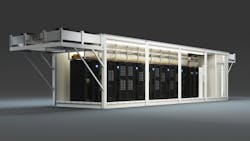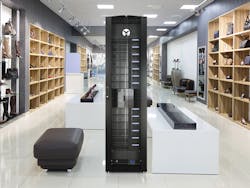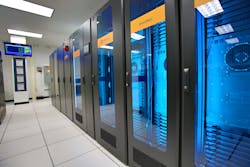What will a data center at the edge look like?
By Martin Olsen,
Increasingly, the edge is where businesses of all sizes are doing some of their most impactful computing. The vast amount of data at our fingertips and the increased demand for computing is driving computer ever closer to users. It’s a multi-billion-dollar market with projected compound annual growth rate (CAGR) of more than 26% in the next 5 years.
To put the dollars into a facility perspective, a recent Vertiv study of more than 800 data center professionals showed an expected growth in the number of edge sites of 226% between now and 2025. Most of these edge sites will be self-owned or operated in conjunction with a third-party operator, according to the Uptime Institute.
Edge sites are typically smaller than traditional data centers, requiring far less physical space, and often turning up in places that weren’t originally designed for IT networks. Edge computing racks often are deployed in closets or repurposed rooms in hospitals, schools, or even military sites in the middle of the desert.
So, what does all this mean?
All of the considerations and best practices of a traditional data center remain important for edge spaces, including power, cooling, security, and monitoring. The remote locations and often-unmanned status of edge environments make features like remote monitoring, security, local service, and reliability even more critical.
Keeping a close eye
Monitoring is important for all types of data centers, but it’s particularly important in edge environments. Edge sites are often in hard-to-access or remote locations. To add to the difficulty, there might not be anyone on-site, let alone a trained IT professional or someone well-versed in data center infrastructure. That’s where the importance of remote monitoring comes to the forefront.
A robust monitoring system allows you to keep track of your edge location’s performance from wherever you are, to ensure it is operating at peak effectiveness. The monitoring solution you choose should allow you to have real-time visibility and control of your data center’s operations.Beyond the individual edge site, it’s critical to be able to see what’s going on in real-time across all your edge locations. Remote monitoring needs to be integrated and standardized, so you can make crucial decisions about your operations instantaneously, while also getting a holistic picture of the health of your network.
But monitoring on its own isn’t enough. You also need a team with expertise ready to jump in when something goes wrong.
Building in redundancies
When something does go wrong, are you prepared? I say “when,” because emergencies and issues are a matter of when, not if.
Because of their nature, edge sites are just as vulnerable, if not more so, than traditional core data centers. As I mentioned, edge sites often are in inhospitable environments, with few technicians around to assist.
The key here is to build in redundancies and to have systems that are fault-tolerant. Because these locations often lack on-site support, it’s important to have reliable backup power. That way, if the power fails, there’s a backup source ready to go.
Modular uninterruptible power supply (UPS) systems can serve an important function here, too. The level of training needed to replace smaller edge-sized modular systems is low. This allows the on-site technician to replace modules quickly and easily, minimizing downtime.
This is especially important in hospitals and other settings that rely on data and the infrastructure to make important and possibly life-altering decisions.
Securing the edge
Let’s think about an edge site in a back room of a retail store. The store management needs to manage the vast amount of data related to inventory and customers—and keeping the data close to the source means personnel can analyze and use that data more quickly.
When you have confidential and critical computing power in a storage room, security is paramount. The equipment is just steps away from both the public and employees, neither of whom are well-versed in the ins and outs of IT systems and infrastructure.
It would be easy for a well-meaning store employee to accidentally interfere with the equipment, causing damage to the network or even triggering an outage.
These vulnerabilities make physical and virtual security that much more important. Sensors and alarm systems can help ensure equipment is running smoothly—without any accidental or intentional interference from a known user or unknown threat.Secure racks and cabinets keep the servers protected, while integrating cooling, UPS, power distribution, backup ventilation, and even fire suppression—all things that are key in small environments.
More considerations
Often, edge sites are established in areas that receive more foot traffic than a typical data center, like in my earlier example of the retail stock room, or in spots that are exposed to industrial or outdoor elements.
These settings will require a sealed system, like an enclosed rack, to protect against dust, moisture, and other contaminants. This characteristic is even more important with edge sites that are outdoors, such as military installations and cell sites.
Edge sites also often need dedicated, closed-loop cooling, because you can’t rely on comfort cooling alone. In our retail example, comfort cooling may cycle off when the store is closed or during off-peak hours. Or, when the store is busy, the temperature may be higher than on a slow day.
Row-based or in-rack cooling solutions can deliver the temperature and humidity consistency that sensitive electronics need, without taking up valuable floor space.
For sites that have floor-loading issues, or are sensitive to the operating considerations of valve-regulated lead-acid (VRLA) batteries, data center customers increasingly are turning to lithium-ion batteries for edge use cases because they are smaller and lighter, have much higher energy density, have a longer life, and have reduced maintenance needs.
So what will your network ecosystem look like? It’s important to note that traditional data centers, as well as hyperscale and colocation options, won’t go away, especially because many users rely on a hybrid approach to manage their networks.
But as we have seen, the rise of the edge has implications for how data centers look and behave. Security, monitoring and reliability become that much more important when we are in edge environments.
The shift to the edge won’t happen all at once. It’s happening now, and will steadily grow over time. Now is the time to embrace edge computing and to learn its unique physical infrastructure needs.
Martin Olsen is vice president, global edge and integrated solutions at Vertiv.


